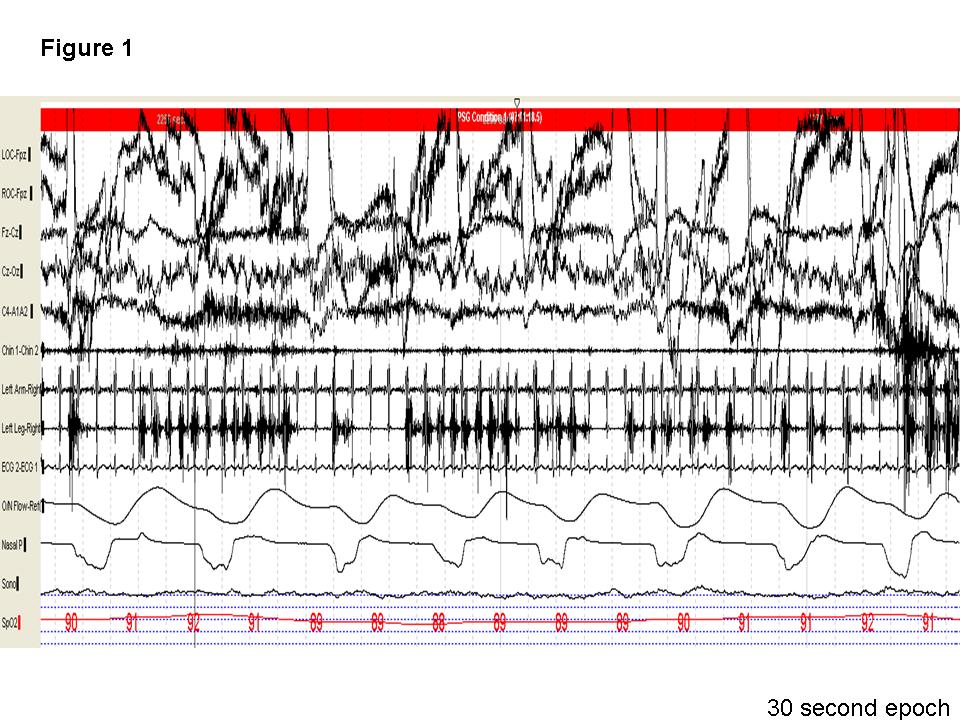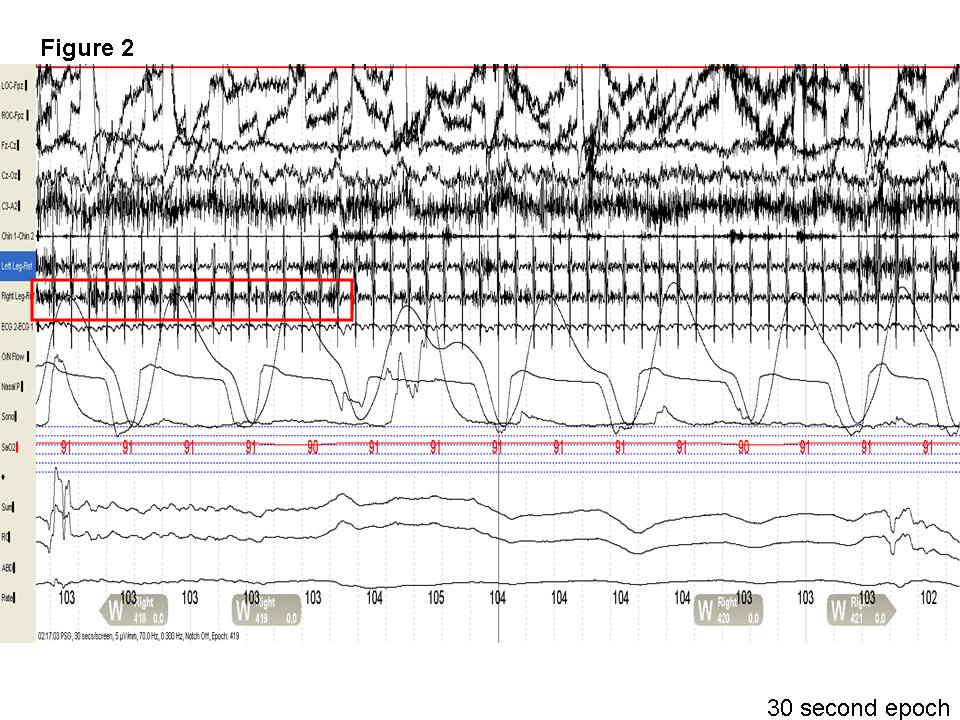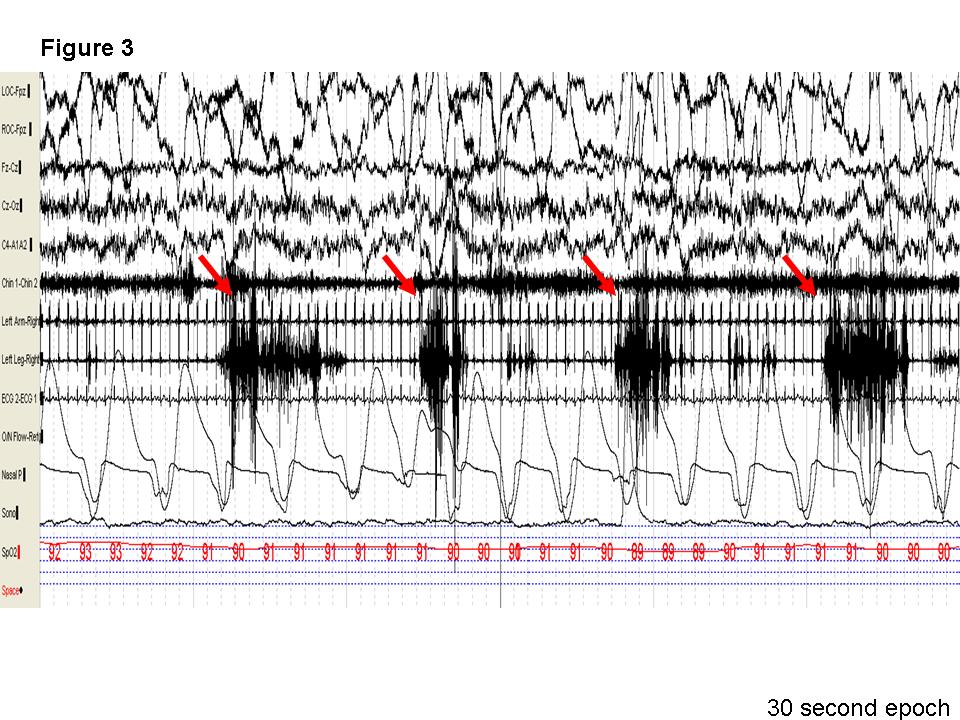Contributed by Kannan Ramar, MD, Division of Pulmonary, Sleep and Critical Care Medicine, Mayo Clinic, Rochester, MN
Question: An 83 year-old woman presented to our center for further evaluation and management of snoring, witnessed apneas, restless leg syndrome (RLS), and leg movements during sleep (periodic leg movements). A 30-second epoch (Figure 1) of an incidental finding that was noted during the polysomnogram (PSG) and a video fragment are shown. What is the noted finding?
Answer: Hypnagogic foot tremor
Discussion: Note the presence of recurrent right leg movements (left leg is covered by a sheet) in the first 10 seconds and the last 15 seconds of the video as the patient transitions from wake to stage N1 and in stage N1 respectively. Similarly, the 30-second epoch shows recurrent electromyographic (EMG) potentials at 1-2 Hz in the right leg with burst potentials greater than 250 milliseconds, lasting for longer than 10 seconds. This meets the criteria for hypnagogic foot tremors(1). Though alternating leg muscle activation (ALMA) is also a possible diagnosis, the surface EMG recorded activity (Figure 2) only from the right (indicated by the red box) and not from the left anterior tibialis muscle (highlighted by blue on figure 2). Of interest, periodic leg movements during wakefulness and not during sleep were also noted in our patient (Figure 3, red arrows).
Hypnagogic foot tremor (HFT) was first described by Broughton in 1988(2). HFT is rhythmic movement of the feet or toes that occurs at the transition between wake and sleep, during non rapid eye movement (NREM) sleep (mostly during stage N1 and N2 sleep), or in some patients following arousals(1, 3, 4). The frequency of HFT may be increased in other sleep disorders such as RLS (6 out of 28 patients – 21%) and sleep related breathing disorders (22 out of the 28 patients – 79%) (5), though it can also occur during normal sleep (1,5). The association of HFT with other sleep disorders has not been clearly established. HFT appears to be an incidental finding as it does not appear to have sleep disturbing effects as noted on the PSG (5). The exact prevalence of HFT in the general population is unknown. Wichniak and colleagues found that 7.5% of the 375 consecutive patients undergoing polysomnography for other reasons, also showed HFT(5). ALMA has a pattern similar to HFT with the exception of successive EMG potentials alternating between the legs. HFT may cause sleep disruption and insomnia if it is severe and prolonged.
HFT and ALMA are considered benign, with uncertain clinical significance, and (1, 3, 5) may not require treatment. In fact, the presence of HFT in our patient on the PSG was not associated with sleep disturbing effects and she was not aware of these movements. HFT may need to be distinguished from other sleep related movement disorders such as periodic limb movement disorder (PLMD), sleep related rhythmic movement disorder, and propriospinal myoclonus at sleep onset(1). Our patient was counseled and treated for RLS with a dopaminergic agonist and her symptoms of RLS improved. Follow up polysomnogram study was not needed and therefore not performed to monitor for HFT.
References
- American academy of sleep medicine. International classification of sleep disorders: Diagnostic and coding manual. Westchester, IL: American Academy of Sleep Medicine; 2005.
- Broughton R. Pathological fragmentary myoclonus, intensified hypnic jerks and hypnagogic foot tremor: Three unusual sleep-related movement disorders. In: Koella WP, Obal F, Schulz H, Visser P, eds. Stittgart: Gustav Fischer Verlag; 1988:240-3.
- Walters AS. Clinical identification of the simple sleep-related movement disorders. Chest 2007;131(4):1260-1266.
- Walters AS, Lavigne G, Hening W, Picchietti DL, Allen RP, Chokroverty S, Kushida CA, Bliwise DL, Mahowald MW, Schenck CH, et al. The scoring of movements in sleep. J Clin Sleep Med 2007;3(2):155-167.
- Wichniak A, Tracik F, Geisler P, Ebersbach G, Morrissey SP, Zulley J. Rhythmic feet movements while falling asleep. Mov Disord 2001;16(6):1164-1170.






